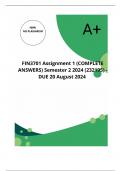,QUESTION 1 [20 marks] Batlokwa Industries wishes to select
one of three possible machines, each of which is expected to
satisfy the firm’s ongoing need for additional aluminium extrusion
capacity. The three machines, A, B and C, are equally risky. The
firm plans to use a 12% cost of capital to evaluate each of them.
The initial investment and annual cash inflows over the life of
each machine are shown in the following table: Year Machine A
Machine B Machine C 0 (R92 000) (R65 000) (R100 500) 1 R12
000 R10 000 R30 000 2 R12 000 R20 000 R30 000 3 R12 000
R30 000 R30 000 4 R12 000 R40 000 R13 000 5 R12 000 - R30
000 6 R12 000 - REQUIRED: 1.1 Calculate the NPV for each of
the three projects. (9 marks) 1.2 Calculate the annualised net
present value (ANPV) of each machine. (9 marks) 1.3 Based on
the NPV and IRR calculated above, would you advise Batlokwa
(Pty) Ltd to invest their funds in the replacement? Give a reason
for your answer. (2 marks) THERE ARE TWO COMPULSORY
ASSIGNMENTS FOR THE SECOND SEMESTER. The purpose
of this assignment is to evaluate your knowledge of the
fundamental aspects of decision-making for long-term investment.
Study chapters 9, 10, 11 and 12 in the prescribed book as well as
the relevant learning units to complete this assessment. 11
Let's start with the calculations for Net Present Value (NPV) and
Annualised Net Present Value (ANPV) for each machine.
1.1 Calculate the NPV for each of the three projects
The NPV formula is: NPV=∑(Ct(1+r)t)−C0\text{NPV} = \sum
\left( \frac{C_t}{(1 + r)^t} \right) - C_0NPV=∑((1+r)tCt)−C0
, Where:
• CtC_tCt = cash inflow at time ttt
• rrr = discount rate (12% or 0.12)
• ttt = year
• C0C_0C0 = initial investment
Machine A
NPVA=(12 000(1+0.12)1+12 000(1+0.12)2+12 000(1+0.12)3+12
000(1+0.12)4+12 000(1+0.12)5+12 000(1+0.12)6)−92 000\text{N
PV}_A = \left( \frac{12\,000}{(1+0.12)^1} +
\frac{12\,000}{(1+0.12)^2} + \frac{12\,000}{(1+0.12)^3} +
\frac{12\,000}{(1+0.12)^4} + \frac{12\,000}{(1+0.12)^5} +
\frac{12\,000}{(1+0.12)^6} \right) - 92\,000NPVA
=((1+0.12)112000+(1+0.12)212000+(1+0.12)312000
+(1+0.12)412000+(1+0.12)512000+(1+0.12)612000)−92000
Machine B
NPVB=(10 000(1+0.12)1+20 000(1+0.12)2+30 000(1+0.12)3+40
000(1+0.12)4)−65 000\text{NPV}_B = \left(
\frac{10\,000}{(1+0.12)^1} + \frac{20\,000}{(1+0.12)^2} +
\frac{30\,000}{(1+0.12)^3} + \frac{40\,000}{(1+0.12)^4} \right)
- 65\,000NPVB=((1+0.12)110000+(1+0.12)220000
+(1+0.12)330000+(1+0.12)440000)−65000
Machine C
NPVC=(30 000(1+0.12)1+30 000(1+0.12)2+30 000(1+0.12)3+13
000(1+0.12)4+30 000(1+0.12)5)−100 500\text{NPV}_C = \left(
\frac{30\,000}{(1+0.12)^1} + \frac{30\,000}{(1+0.12)^2} +
\frac{30\,000}{(1+0.12)^3} + \frac{13\,000}{(1+0.12)^4} +
\frac{30\,000}{(1+0.12)^5} \right) - 100\,500NPVC





